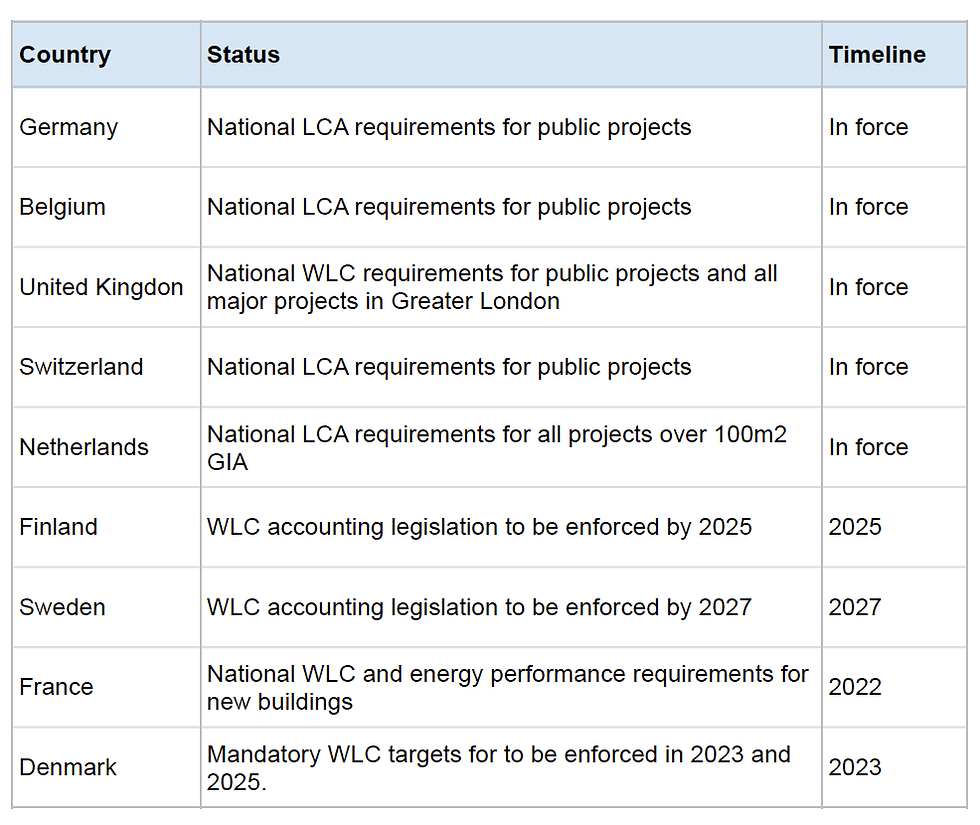Environmental regulations in construction — What’s changing?
- 2050 Materials
- Apr 13, 2022
- 3 min read
Updated: Jan 23, 2023

Building regulations are crucial drivers for change.
Over the last decade, regulatory compliance was concentrated on LED bulbs, energy-efficient ventilation and insulated buildings. Today, the focus is shifting more and more towards material selection and upfront carbon.
Designing with operational carbon in mind is obviously helpful, yet not adequate to ensure future compliance and long-term asset value. Energy and carbon metrics are complementary and are key factors in decarbonizing the building stock.
More governments are starting to realize that regulating and enforcing thresholds in the operational aspect of buildings is insufficient when trying to build a net-zero society. In order to reduce the embodied carbon in the material selection and specification process, new requirements need to be introduced with limited values based on whole-life carbon assessments.
The introduction of embodied carbon regulations needs to be implemented at a global scale. Countries such as Denmark, France and the Netherlands are leading the way in this space.
The current status in Europe
Here’s a summary of the most impactful regulations driving embodied carbon accounting in Europe:

Germany, Belgium, UK, and Switzerland: All 4 countries have introduced LCA requirements for public projects and state-owned buildings. In addition, the Mayor of London has introduced a requirement for all major referable projects to calculate and reduce whole life-cycle carbon (WLC) emissions to fully capture a development’s carbon impact.
Netherlands: All new commercial and residential buildings with a GIA larger than 100m2 need to calculate and report their embodied impacts based on a standardized and simplified national LCA methodology.
France: The new building regulation (RE2020) introduced by the French government aims to address the environmental impact of new buildings by enforcing the combination of whole-life carbon accounting and energy performance targets. This is supported by the E+C- label, which standardizes and simplifies a national LCA methodology to ensure compliance.
Finland and Sweden: Both countries have developed whole-life carbon databases in line with standardized and simplified national LCA methodologies, to pave the way for whole-life carbon accounting and future regulation. Sweden plans to introduce CO2 thresholds for new buildings by 2027 and Finland by 2025.
Denmark: The Danish government introduced targets and carbon thresholds in the building regulations for whole life carbon which come into effect in 2023, embracing both embodied and operational carbon in all buildings over 1000m2 in any sector. Regulatory thresholds for smaller buildings are expected to be enforced by 2025.

Further to the introduction of new government regulation, several industry groups in Europe and the UK (such as ACAN, Architects Declare and Part Z) consisting of sustainability specialists, designers and contractors are advocating for more aggressive action plans to address the climate emergency.
Part Z proposes an amendment to the UK Building Regulations, outlining the requirements on the assessment of whole-life carbon emissions, and limiting of embodied carbon emissions, for all major building projects.
Can operational carbon regulation pave the way for embodied carbon accounting?
The importance of embodied carbon emissions will increase dramatically as more buildings are constructed and renovated to higher energy performance and efficiency standards.
The enhancement of operational performance in new buildings and retrofits is expected to create a multiplier effect on two fronts:
The overall energy consumption of buildings is reduced, and this automatically turns into a minimum requirement.
Embodied carbon becomes the most significant area of carbon emissions over the lifetime of a building.
Therefore, it makes sense to focus on untapped carbon savings and set targets for emissions from the extraction, manufacturing and construction processes in building materials and products.
How do you measure whole-life carbon emissions?
Multiple standards and professional statements have already been released to provide guidance and outline how to measure whole-life carbon emissions.
Some of the most relevant are:
BS EN 15978: Defines the general structure and definition of stages in the life cycle of buildings, according to the European standard for the environmental assessment of buildings and the sustainability of construction works.
ISO 21930:2017 & EN 15804: Provide the principles, specifications and requirements for developing Environmental Product Declarations.
EN 15643–5: Outlines how to assess the sustainability of buildings and civil engineering works.
RICS Professional Statement — Whole-life carbon assessment for the built environment: Sets out specific mandatory principles and supporting guidance for the interpretation and implementation of EN 15978 methodology.
Carbon management and accounting needs to be more accessible to industry stakeholders. The ultimate goal should be to regulate embodied carbon in the same manner that energy performance is currently mandated, including robust and standardized calculation methods at affordable prices.
Countries that have taken a progressive approach on operational carbon regulations, are also first to enforce embodied carbon thresholds.
Integrate resilience in your design
Designing today with future compliance in mind isn’t easy, no doubt.
2050 Materials is making this viable through easy-to-use tools integrating product-specific data.
Implementing such a mentality into the early design stages directly contributes to delivering long-term asset value for your clients. Besides, it helps you demonstrate a “best-in-class” approach, visionary qualities, and new era creativity.
